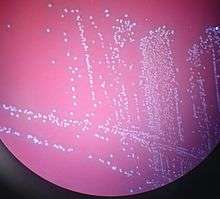Aerococcus
Aerococcus is a genus in the phylum Firmicutes (Bacteria).[1] The genus was first identified in 1953 from samples of air and dust as a catalase-negative, gram-positive coccus that grew in small clusters.[2] They were subsequently found in hospital environments and meat-curing brines.[3] It has been difficult to identify as it resembles alpha-hemolytic Streptococcus on blood agar plates and is difficult to identify by biochemical means.[4] Sequencing of 16S rRNA has become the gold standard for identification, but other techniques such as MALDI-TOF have also been useful for identifying both the genus and species.[4]
| Aerococcus | |
|---|---|
 | |
| Scientific classification | |
| Domain: | |
| Phylum: | |
| Class: | |
| Order: | Lactobacillales |
| Family: | |
| Genus: | Aerococcus Williams et al., 1953 |
| Type species | |
| A. viridans Williams et al., 1953 | |
Etymology
The name Aerococcus derives from the Greek aer, aeros (ἀήρ, ἀέρος), air; New Latin coccus (from Greekkokkos (κόκκος)), a berry; New Latin Aerococcus, air coccus.[5] The name was given based on its round shape and that it was first discovered in air samples.[2]
Species
The genus contains these species:[5]
- A. christensenii Collins et al., 1999, named after the Danish microbiologist Jens J. Christensen[6]
- A. sanguinicola Lawson et al., 2001 (from the Latin for blood-dweller)[7]
- A. suis Vela et al., 2007 (Latin for "of a hog")[8]
- A. urinae Aguirre & Collins, 1992 (Latin for "of urine")[9]
- A. urinaeequi (Garvie, 1988) Felis et al., 2005 (Latin for "of the urine of a horse", source of isolation of the type strain)[10]
- A. urinaehominis Lawson et al., 2001 (Latin for "of the urine of a human", source of isolation of the type strain)[11]
- A. viridans Williams et al., 1953 – type species of the genus (Latin for "making green", producing a green color).[12] Causative agent of gaffkaemia, a disease of lobsters.[13]
See also
References
- Classification of Genera AC entry in LPSN [Euzéby, J.P. (1997). "List of Bacterial Names with Standing in Nomenclature: a folder available on the Internet". International Journal of Systematic and Evolutionary Microbiology. 47 (2): 590–2. doi:10.1099/00207713-47-2-590. PMID 9103655.]
- Williams, R. E. O.; Hirch, A.; Cowan, S. T. (1953-06-01). "Aerococcus, a New Bacterial Genus". Journal of General Microbiology. 8 (3): 475–480. doi:10.1099/00221287-8-3-475. PMID 13061751.
- Aguirre, M.; Collins, M. D. (1993-05-01). "Development of a polymerase chain reaction test for specific identification of the urinary tract pathogen Aerococcus urinae". Journal of Clinical Microbiology. 31 (5): 1350–1353. ISSN 0095-1137. PMC 262936. PMID 7684752.
- Rasmussen, Magnus (Jun 2013). "Aerococci and aerococcal infections". Journal of Infection. 66 (6): 467–474. doi:10.1016/j.jinf.2012.12.006. PMID 23277106.
- Aerococcus entry in LPSN [Euzéby, J.P. (1997). "List of Bacterial Names with Standing in Nomenclature: a folder available on the Internet". International Journal of Systematic and Evolutionary Microbiology. 47 (2): 590–2. doi:10.1099/00207713-47-2-590. PMID 9103655.]
- "Note: Aerococcus christensenii sp. nov., from the human vagina". Ijs.sgmjournals.org. 1999-07-01. Archived from the original on 2009-12-03. Retrieved 2012-07-06.
- "Notification that new names and new combinations have appeared in volume 50, part 2, of the IJSEM". Ijs.sgmjournals.org. 2001-05-01. Archived from the original on 2008-08-28. Retrieved 2012-07-06.
- Vela, A. I.; Garcia, N.; Latre, M. V.; Casamayor, A.; Sanchez-Porro, C.; Briones, V.; Ventosa, A.; Dominguez, L.; Fernandez-Garayzabal, J. F. (2007). "Aerococcus suis sp. Nov., isolated from clinical specimens from swine". International Journal of Systematic and Evolutionary Microbiology. 57 (6): 1291–1294. doi:10.1099/ijs.0.64537-0. PMID 17551045.
- "Validation of the Publication of New Names and New Combinations Previously Effectively Published Outside the IJSB". Ijs.sgmjournals.org. 1992-07-01. Archived from the original on 2009-04-18. Retrieved 2012-07-06.
- Giovanna E. Felis; Sandra Torriani; Franco Dellaglio (2005-01-14). "Reclassification of Pediococcus urinaeequi (ex Mees 1934) Garvie 1988 as Aerococcus urinaeequi comb. nov". Ijs.sgmjournals.org. Archived from the original on 2008-04-30. Retrieved 2012-07-06.
- P A Lawson; E Falsen; M Ohlén; M D Collins (2001-03-01). "Aerococcus urinaehominis sp. nov., isolated from human urine". Ijs.sgmjournals.org. Archived from the original on 2008-10-10. Retrieved 2012-07-06.
- "Approved Lists of Bacterial Names". Ijs.sgmjournals.org. 1980-01-01. Archived from the original on 2009-09-04. Retrieved 2012-07-06.
- Spencer J. Greenwood; Ian R. Keith; Béatrice M. Després; Richard J. Cawthorn (2005). "Genetic characterization of the lobster pathogen Aerococcus viridans var. homari by 16S rRNA gene sequence and RAPD" (PDF). Diseases of Aquatic Organisms. 63 (2–3): 237–246. doi:10.3354/dao063237. PMID 15819439.